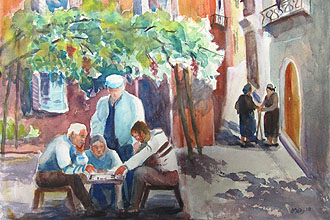|
| Magriel's NYT Columns |
 The eighth Big Apple Championship, sponsored by the Metropolitan Backgammon Association, was held recently in New York, with 160 participants. Robert Bishop and Mike Singer, the two finalists, agreed to share the first prize without playing because this one-night event took longer than expected. Lee Fine and Irwin Zamore were the losing semifinalists.
The eighth Big Apple Championship, sponsored by the Metropolitan Backgammon Association, was held recently in New York, with 160 participants. Robert Bishop and Mike Singer, the two finalists, agreed to share the first prize without playing because this one-night event took longer than expected. Lee Fine and Irwin Zamore were the losing semifinalists.
The final standings in this tournament were suprisingly similar to the seventh Big Apple Championship, in which Mike Singer won; Robert Bishop and Lee Fine were semifinalists.
In other results, Paul McGowan overcame Barry Greenburg in the consolation; John Barnett beat David Gustin in the intermediate.
In backgammon, mistakes can result not only from faulty analysis and evaluation, but also from simple oversight. Frequently the best play is not even considered! It is not uncommon for experienced players to overlook the correct move and settle for an inferior one. The diagrammed position, taken from a late round of play, shows how this can happen.
|
| Black to play 4-1. |
With only one checker back in White’s home board, Black wished to play conservatively. He rejected 8/4, 6/2, or 13/9 because they left a new blot for White to hit and so send a second man back. Reluctantly, Black played his 4, 24/20 — the only play that did not expose an extra blot.
This proved to be a costly mistake. White next rolled a 6-2 and played 18/20*, 14/20, hitting Black and simultaneously making the 20-point. Black failed to reenter and White next remade his 18-point to form a five-in-a-row prime that ultimately won the game.
Among the four alternatives that Black looked at, 24/20 is probably the most dangerous. Moving up to the 20-point, on which White has four builders bearing, is called “coming under the gun.” It provokes White to attack Black and facilitates making the vital 20-point. If compelled to choose one of these alternatives, the least injurious would be 8/4, slotting the 4-point. Although not without risk, Black can make the 4-point and give himself a powerful home board if White doesn’t hit with a 3.
None of the alternatives Black considered was correct. After Black rolled a 4-1, his reasoning immediately went off track when he unthinkingly played the 1, 6/5. The correct play, which Black overlooked entirely, is 5/4, 8/4, making the 4-point.
Black’s mistake, simply overlooking the best play, can happen to players at all levels, especially after long hours of play. However, such mistakes are less likely to occur if a player always considers the entire roll before playing any part of it.
Thus, it is unwise to play the “obvious” part of a roll, such as the 1 in the diagram, and then think how to complete the play. After rolling, the correct procedure is to first quickly scan the board to find all the reasonable plays. Only after this is done, and you are confident that no plays have been overlooked, can you start to decide among the alternatives. This procedure is particularly important when playing small doubles.
Rollout
 Tom Keith 2013 |
|
Money play Centered cube Black rolls 4-1 1296 games with VR Checker play: 2-ply Cube play: 3-ply Red |
| 4-1: | Game | G | BG | Equity | ||||
| 1 | 24/20, 6/5 |
W L |
.4966 .5034 |
.1844 .1212 |
.0191 .0046 | +0.0708 |

| (a) |
| 2 | 8/4, 6/5 |
W L |
.4671 .5329 |
.1904 .1257 |
.0168 .0063 | −0.0404 | (0.1112) | |
| 3 | 8/4, 5/4 |
W L |
.4516 .5484 |
.1656 .1116 |
.0170 .0046 | −0.0997 | (0.1705) | (b) |

|
|

